It was a visit which was intended to be a warning and was duly seen as one. Twenty-four hours after Google announced that the Chinese technology group Huawei would no longer have access to its Android operating system, China's president Xi Jinping, accompanied by his chief negotiator Lie He, conspicuously made a visit to the production site of JL MAG rare-Earth Co. Ltd at Ganzhou in southern China. This group specialises in the research and development of rare earth permanent magnetic materials.
The message could not have been clearer: Beijing was warning Washington that it, too, had the means to retaliate in the trade war in which it is embroiled with the United States. And among those means are rare earths. During their bilateral discussions on the sidelines of the G20 summit in Osaka in Japan on Friday June 28th, US president Donald Trump and Xi Jinping are thought to have discussed the issue of rare earths, a sign of just how crucial they have become in the geopolitics of raw materials.

But what exactly are rare earths and why do they matter? “It's a family of metals which includes 17 elements and 15 metals. They are called rare because they are combined in miniscule quantities with other metals or minerals which are very abundant,” says Guillaume Pitron, author of the book 'La Guerre des Métaux Rares' ('The War of the Rare Metals'). Among these rare metals there are some names that are relatively well known such as cobalt, antimony, magnesium, gallium and germanium, and others, such as neodymium and promethium, which are much less so.
All these elements have become essential for use in new technologies ranging from the digital world and the transition to greener energies to applications in space and military hardware. These rare metals can be found in everything from mobile phones, computers, satellites, optic fibre networks, batteries, electric engines and hybrid motors to magnets, superconductors, photovoltaic panels and lasers, even if in some cases as little as a gramme is used.
But the supply of these rare elements and metals is almost exclusively in Beijing's hands as almost 80% of world production of them is currently on Chinese territory. Strategically this gives and will continue to give China enormous power.
This was not always the case. The mine at Mountain Pass in California once made the United States, along with Australia, the leading producer of rare elements. France, through the French group Rhône-Poulenc, was at one time the leading refiner of rare earths.
But the mining of rare earths is “very dirty and very polluting”, says Guillaume Pitron, spotlighting the hidden world behind the digital and energy revolutions. It requires lengthy chemical processes to extract rare earths which are often present in minute quantities mixed with other minerals, some of them radioactive.
“The mining of rare earths has been the source of many social and environmental conflicts,” says Guillaume Pitron. In 2002, for example, the Mountain Pass mine was closed following several environmental problems. It reopened under new ownership in 2009 but producing less than before.

Enlargement : Illustration 2

The abandonment of rare earth mining by Western countries was made easier by the fact that they have an alternative: China. “China squared the circle for Western industrialists by proposing to take charge of the rare earths for everyone. Everyone rushed to relieve themselves of this highly polluting and not very profitable activity.”
At the time, it is true, the uses of rare earths were relatively limited: they were used in catalytic converters for diesel vehicles, for alloys and for integrated circuits. But no one foresaw their use in future technologies. And as the market is 'always right', short-term economic calculations won out over all other considerations.
“No one was on their guard about the fact that China would find itself in a position of near-monopoly,” says Guillaume Pitron. However, China itself has been focussed on rare earths for a long time. At the start of the 1980s the authorities in Beijing decided to make them one of the strategic sectors in the country's development, and it increased its production to boost its foreign currency reserves.
But Chinese firms did not just extract the minerals, they also sought to add value to them, moving on from the basic raw material to treating them and then to making the components that use rare earths, from sub-assembly work to manufacturing complete technologies. Western government completely abandoned the sector to them. According to United States government figures, China produced more than 90% of the world’s supply of rare earths over the last decade.
In 2006 China changed its approach and focussed more on the products that would benefit its own industries and it began to impose controls on the price and quotas for its exports of rare earths.
Strategic metals
The production of these rare metallic elements has now become crucial, not least for the military. Every modern fighter aircraft has components containing rare earths. “Quite early on American defence staff were worried by this dependency; for example they explained that there were magnets in missiles which were indispensable but which were only made in China, something which placed the United States in a vulnerable position. But they weren't listened to,” says Guillaume Pitron.

Enlargement : Illustration 3

It was Donald Trump who was the first to sound the alarm, raising the issue of American access to resources needed for strategically-important equipment. On December 20th 2017 the US president issued an executive order seeking to “ensure secure and reliable supplies of critical minerals” - minerals such as uranium and rare earths – to help safeguard American security.
Then in early June 2018 the US government adopted a series of measures to wrestle back control in this sector. A list of 35 minerals judged to be critical to US security, ranging from niobium to lithium, and from nickel to bismuth, was drawn up.
Investments were also pledged to renew the production of rare earths and to kick-start the whole industrial sector again. US commerce secretary Wilbur Ross said in June 2019 that Washington was ready to adopt “unprecedented action to ensure that the United States will not be cut off from these vital materials”. However, as French expert Guillaume Pitron points out: “According to the American Government Accountability Office it can take up to 15 years to re-establish an entire supply chain.”
Meanwhile the Chinese government seems keen to take advantage of the balance of power that is currently in its favour in relation to rare earths. “The United States produces mainstream electronic [goods] and military equipment which is heavily dependent on Chinese rare earths. It should not underestimate China's ability to safeguard its economic interests and its desire for development,” warned the People's Daily, the Chinese Communist Party's official newspaper.
But could China go as far as proclaiming a complete embargo on the export of rare earths, in retaliation for American trade sanctions? In 2011 the Beijing authorities played this card against Japan following a territorial dispute over the Senkaku Islands, which belong to Japan but are claimed by China. The Chinese froze all exports of rare earths to Japan which is the main consumer of these materials in the world after China itself.
As a result the price of these commodities shot up and Japanese companies that use them found themselves in serious difficulty. In 2012 Japan, the United States and Europe filed a case with the World Trade Organisation (WTO) in reaction to Chinese restrictions on rare earths. In 2014 the WTO ruled against China and the latter lifted all its restrictions on them.
“I don't think China is going to impose a new embargo on rare earths. I think that its strategy is more to control the entire supply chain, from the beginning to the end,” says Guillaume Pitron.
However, the tensions over rare earths have already been profitable for China, especially as such a restricted market encourages price speculation. For example, the price of neodymium, which was under 40 dollars a kilo, rose above 50 dollars after President Xi Jinping's threats. Depending on how the trade war between the US and China pans out, some analysts expect massive volatility in the prices of rare earths in the near future.
The issue of maintaining access to rare earths, meanwhile, is not going away any time soon. The transition to greener energy and the digital sector both rely on their use. Within ten years some 200 million electric cars are expected to be on the world's roads. That will require an increased use of lithium, neodymium and other strategically-important elements. “The issue of recycling will inevitably come up. But which metal should one choose?” asks Guillaume Pitron.
Indeed, as a result of its recent experiences Japan has now started its own rare earth recycling sector to recover all it can from used products. This will allow the country to reduce its dependence on Chinese imports. American high-tech companies are also looking at ways to recover used materials. Europe, meanwhile, talks about energy transition and digital development without really worrying about the industrial and strategic resources that are needed to put them into practice and retain control of them. A list of strategic elements has been drawn up but so far the policy response has not gone much further.
Yet the trade friction between the United States and China, once more aired at the G20 summit in Japan, should serve as a warning to Europe. A new form of geopolitics in terms of raw materials is taking shape. This new geopolitical struggle could well produce the same battles for power and influence which were seen over oil for more than a century.
---------------------------------------------------------------------------
- The French version of this article can be found here.
English version by Michael Streeter


